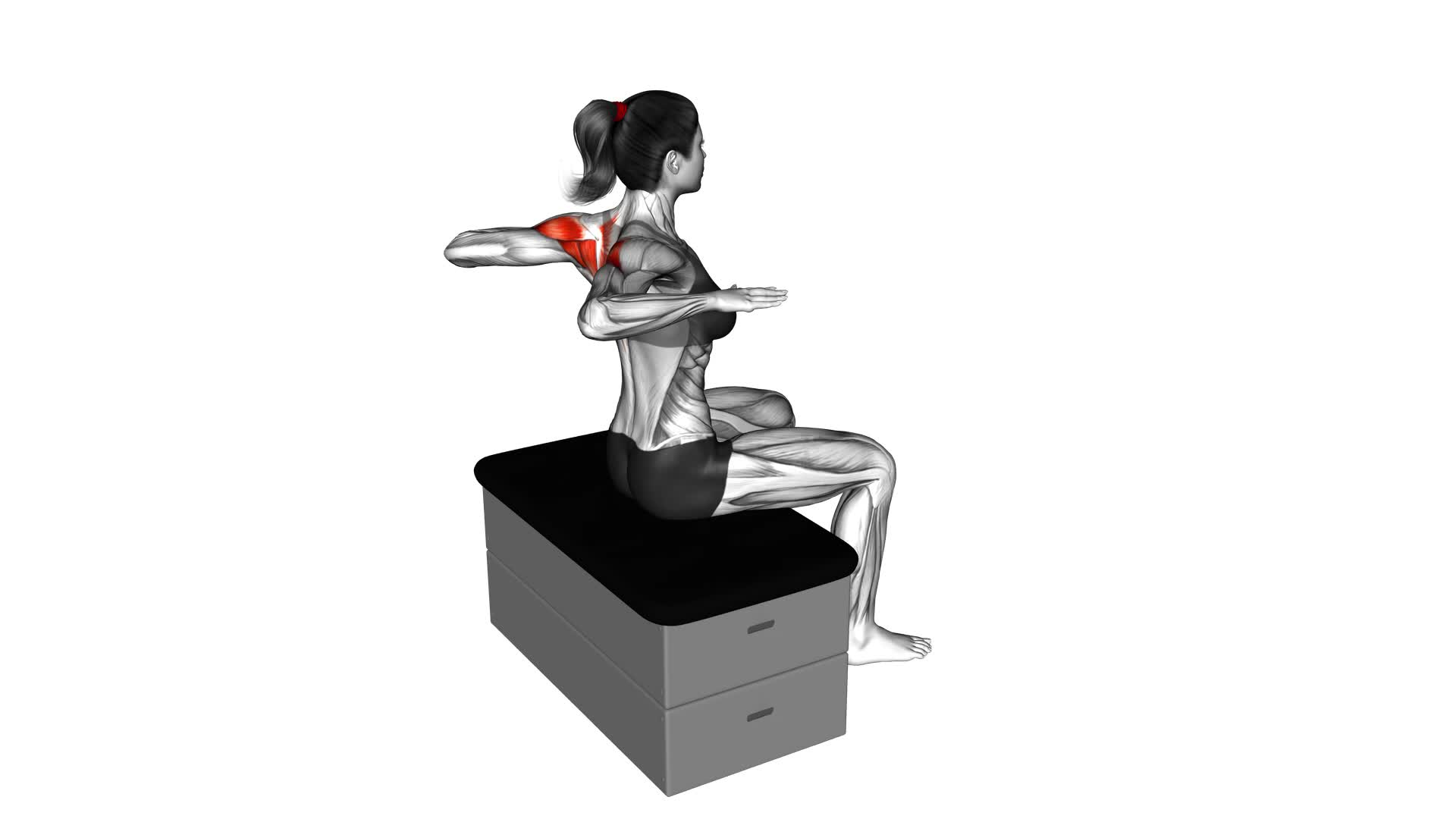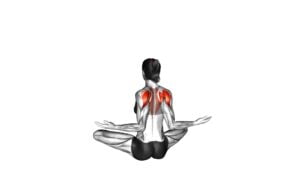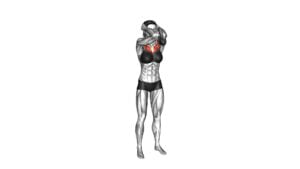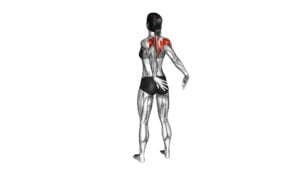Back Squeeze (female) – Video Exercise Guide & Tips

Are you looking for an effective exercise to strengthen your back? Look no further than the back squeeze!
Watch This Exercise Video
In this video exercise guide, we'll show you the proper form and technique to get the most out of this workout. With variations and progressions to challenge yourself, you'll be on your way to a stronger back in no time.
Avoid common mistakes and maximize your results with our helpful tips.
Let's get started!
Key Takeaways
- Back squeeze exercise improves posture and strengthens the upper back and shoulders.
- It promotes muscle growth and development, enhancing overall physical well-being.
- Back squeeze exercise reduces common postural issues and decreases back pain.
- Incorporating variations and precautions, such as using resistance bands and maintaining proper form, can enhance the effectiveness of the exercise.
Benefits of Back Squeeze Exercise
Experience the numerous benefits of the Back Squeeze exercise. This exercise is highly effective for both posture improvement and upper body strength. When performed correctly, the Back Squeeze exercise can have a significant impact on your overall physical well-being.
One of the key benefits of the Back Squeeze exercise is its ability to improve posture. By targeting the muscles in your upper back and shoulders, this exercise strengthens the muscles responsible for keeping your spine properly aligned. As a result, you'll notice improved posture and a decrease in common postural issues such as rounded shoulders or a hunched back.
In addition to posture improvement, the Back Squeeze exercise also helps to increase upper body strength. By engaging the muscles in your back, shoulders, and chest, this exercise promotes muscle growth and development. Regularly incorporating the Back Squeeze exercise into your fitness routine can lead to increased strength and stability in your upper body.
To ensure you experience the full benefits of the Back Squeeze exercise, it's important to maintain proper form and technique. Transitioning into the subsequent section, we'll discuss the correct way to perform this exercise to maximize its effectiveness and prevent injury.
Proper Form and Technique
To perform the Back Squeeze exercise with proper form and technique, follow these guidelines.
- Start by lying flat on your stomach on a mat or a comfortable surface.
- Place your hands on the back of your head, interlocking your fingers.
- Keep your elbows slightly bent and pointing out to the sides.
- Engage your core muscles by pulling your belly button towards your spine.
Now, squeeze your shoulder blades together as you lift your chest off the ground. Be careful not to use your arms to lift your upper body; the movement should come from your back muscles. Hold the squeeze for a couple of seconds before slowly lowering yourself back down to the starting position.
For back squeeze modifications, you can try using an exercise ball or a stability ball. Instead of lying on the ground, position yourself with your abdomen on the ball and your feet firmly planted on the floor. Perform the exercise in the same manner, squeezing your shoulder blades together as you lift your chest off the ball.
The back squeeze exercise primarily targets the muscles in your upper back, such as the rhomboids and trapezius. It also engages your core muscles, providing stability and support during the movement.
Variation and Progressions
To progress the back squeeze exercise, you can add resistance by holding a dumbbell or resistance band across your chest. This will make the exercise more challenging and help you build strength in your back muscles.
Here are some advanced modifications and equipment options to further enhance your back squeeze workout:
- Use a heavier dumbbell: Gradually increase the weight of the dumbbell to continue challenging your muscles and promoting growth.
- Incorporate a stability ball: Place a stability ball between your back and a wall while performing the back squeeze. This will engage your core and add an element of balance to the exercise.
- Try a resistance band with handles: Attach a resistance band with handles to a sturdy anchor point and hold the handles while performing the back squeeze. This will provide a different type of resistance and target your back muscles in a slightly different way.
- Experiment with different hand positions: Instead of placing your hands on your chest, try placing them behind your head or at your sides. This will change the angle and intensity of the exercise.
By incorporating these advanced modifications and equipment options into your back squeeze routine, you can continue challenging your muscles and making progress.
Now, let's discuss some common mistakes to avoid to ensure you're getting the most out of this exercise.
Common Mistakes to Avoid
To maximize the effectiveness of the back squeeze exercise, it's important to be aware of common mistakes and avoid them. By understanding these common mistakes, you can improve your form and get the most out of this exercise.
One common mistake is relying too much on the arms instead of engaging the back muscles. When performing the back squeeze, make sure to focus on squeezing your shoulder blades together and using your back muscles to complete the movement.
Another mistake isn't maintaining proper posture throughout the exercise. To avoid this, keep your back straight and your chest lifted, avoiding any rounding or hunching of the shoulders.
It's also important to avoid rushing through the exercise. Take your time and focus on squeezing your shoulder blades together with control.
Lastly, be mindful of using too much weight or resistance. Start with a lighter weight and gradually increase as you become stronger.
Tips for Maximizing Your Back Squeeze Workout
Maximize the effectiveness of your back squeeze workout by incorporating these tips:
- Use proper form: To get the most out of your back squeeze workout, make sure you're using proper form. Keep your back straight, engage your core, and squeeze your shoulder blades together with each repetition.
- Focus on mind-muscle connection: Concentrate on the muscles you're targeting during the exercise. Visualize your shoulder blades coming together as you squeeze, and really feel the contraction in your back muscles.
- Gradually increase weight or resistance: As you get stronger, it's important to challenge your muscles by gradually increasing the weight or resistance. This will help you continue to make progress and see results.
- Explore equipment options: While a back squeeze can be done using just your bodyweight, there are also equipment options available. You can use resistance bands, dumbbells, or a cable machine to add variety and intensity to your workout.
By following these tips, you can maximize the effectiveness of your back squeeze workout. Remember to listen to your body, make any necessary modifications, and choose the equipment that works best for you.
Keep pushing yourself and enjoy the benefits of a stronger and more toned back.
Frequently Asked Questions
How Often Should I Perform the Back Squeeze Exercise?
To get the most out of the back squeeze exercise, it's important to know how often to do it. The back squeeze offers many benefits, like improving posture and strengthening your back muscles.
For proper form, stand with your feet shoulder-width apart and squeeze your shoulder blades together.
As for frequency, aim to perform the back squeeze exercise at least three times a week. Remember, consistency is key to seeing results.
Can the Back Squeeze Exercise Help Improve Posture?
The back squeeze exercise can indeed help improve your posture. By incorporating this exercise into your routine, you can strengthen your back muscles, which play a crucial role in maintaining proper posture.
Additionally, the back squeeze exercise can also improve flexibility in your back, allowing you to move more freely and comfortably.
Is It Normal to Feel Soreness in the Back Muscles After Doing the Back Squeeze Exercise?
Feeling soreness in your back muscles after doing the back squeeze exercise is normal. This exercise targets the back muscles, specifically the muscles in the upper and middle back. The soreness is a sign that your muscles are being worked and strengthened.
If the soreness is too intense, you can try modifying the back squeeze exercise by reducing the number of repetitions or using lighter weights.
The benefits of the back squeeze exercise include improved posture and increased back strength.
Can the Back Squeeze Exercise Be Modified for Individuals With Lower Back Issues?
If you have lower back issues, there are modifications and alternatives available for the back squeeze exercise.
It's important to listen to your body and avoid any movements that cause pain or discomfort in your lower back.
You can try performing the exercise on an exercise ball or using a resistance band to reduce the strain on your lower back.
Always consult with a healthcare professional or a certified trainer for personalized advice and guidance.
Are There Any Specific Breathing Techniques to Follow During the Back Squeeze Exercise?
During the back squeeze exercise, it's important to focus on your breathing techniques. By inhaling deeply as you squeeze your shoulder blades together, you engage your core and activate the muscles in your back.
Exhaling as you release the squeeze allows for a controlled and effective movement. These breathing techniques not only enhance the benefits of the back squeeze exercise but also help maintain proper form and prevent unnecessary strain on your lower back.
Conclusion
In conclusion, the back squeeze exercise is a beneficial workout that targets the muscles in your back. By maintaining proper form and technique, you can maximize the effectiveness of this exercise.
It's important to avoid common mistakes and ensure that you're progressing at your own pace. By following these tips and incorporating variations into your routine, you can achieve a strong and toned back.
Keep squeezing and enjoy the benefits of this exercise!

Author
Years ago, the spark of my life’s passion ignited in my mind the moment I stepped into the local gym for the first time. The inaugural bead of perspiration, the initial endeavor, the very first surge of endorphins, and a sense of pride that washed over me post-workout marked the beginning of my deep-seated interest in strength sports, fitness, and sports nutrition. This very curiosity blossomed rapidly into a profound fascination, propelling me to earn a Master’s degree in Physical Education from the Academy of Physical Education in Krakow, followed by a Sports Manager diploma from the Jagiellonian University. My journey of growth led me to gain more specialized qualifications, such as being a certified personal trainer with a focus on sports dietetics, a lifeguard, and an instructor for wellness and corrective gymnastics. Theoretical knowledge paired seamlessly with practical experience, reinforcing my belief that the transformation of individuals under my guidance was also a reflection of my personal growth. This belief holds true even today. Each day, I strive to push the boundaries and explore new realms. These realms gently elevate me to greater heights. The unique combination of passion for my field and the continuous quest for growth fuels my drive to break new ground.







